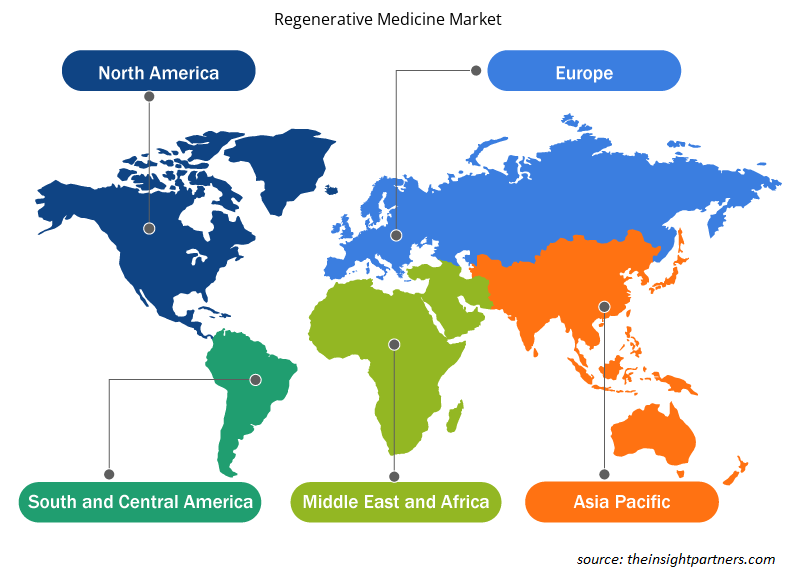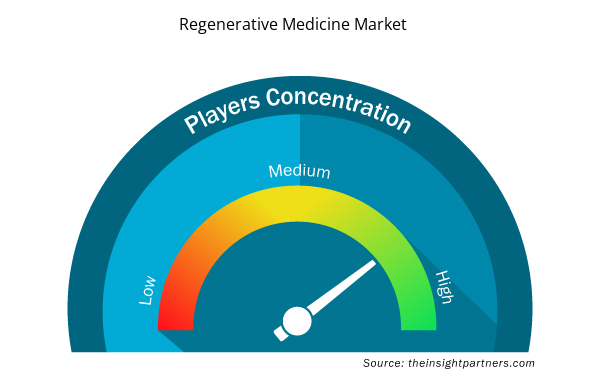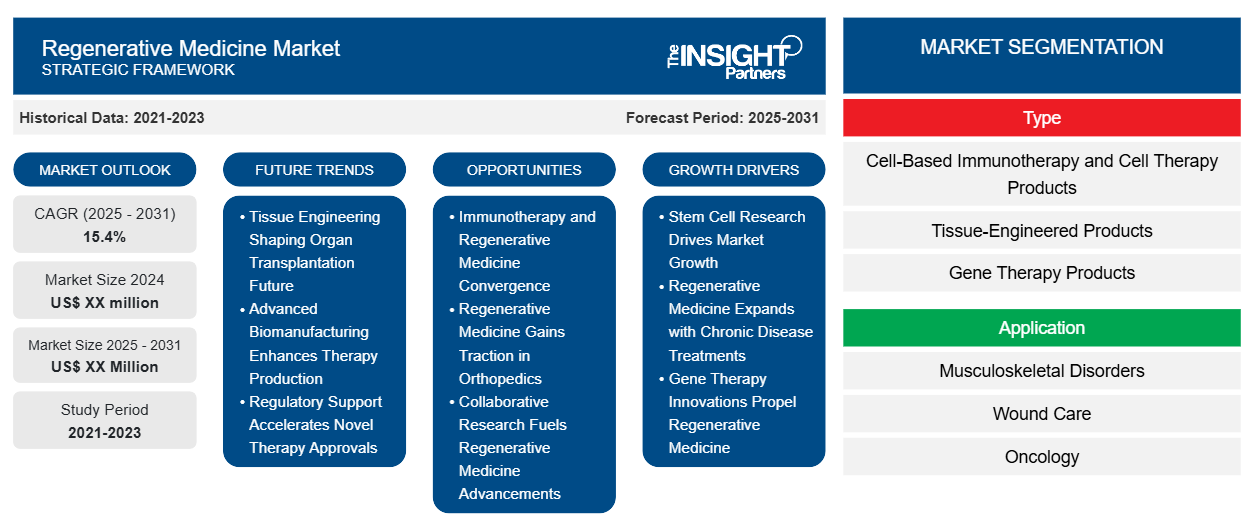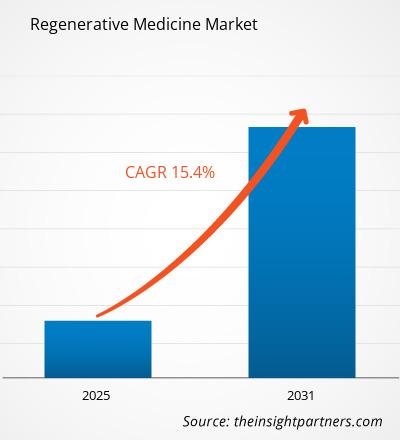Si prevede che il mercato della medicina rigenerativa registrerà un CAGR del 15,4% dal 2023 al 2031, con una dimensione di mercato in espansione da XX milioni di dollari nel 2023 a XX milioni di dollari entro il 2031.CAGR of 15.4% from 2023 to 2031, with a market size expanding from US$ XX million in 2023 to US$ XX Million by 2031.
Il rapporto di mercato sulla medicina rigenerativa comprende l'analisi per tipo (prodotti per immunoterapia e terapia cellulare basati su cellule, prodotti di ingegneria tissutale e prodotti di terapia genica) e applicazione (disturbi muscoloscheletrici, cura delle ferite, oncologia, disturbi oculari e diabete). Il rapporto di ricerca fornisce una panoramica globale e regionale del mercato.Immunotherapy and Cell Therapy Products, Tissue-Engineered Products, and Gene Therapy Products) and Application (Musculoskeletal Disorders, Wound Care, Oncology, Ocular Disorders, and Diabetes). The research report provides a global and regional overview of the market.
Scopo del rapporto
Il report Regenerative Medicine Market di The Insight Partners mira a descrivere il panorama attuale e la crescita futura, i principali fattori trainanti, le sfide e le opportunità. Ciò fornirà spunti a vari stakeholder aziendali, come:
- Fornitori/produttori di tecnologia: per comprendere le dinamiche di mercato in evoluzione e conoscere le potenziali opportunità di crescita, consentendo loro di prendere decisioni strategiche informate.
- Investitori: condurre un'analisi completa delle tendenze relative al tasso di crescita del mercato, alle proiezioni finanziarie del mercato e alle opportunità esistenti lungo la catena del valore.
- Enti di regolamentazione: regolamentano le politiche e le attività di controllo sul mercato allo scopo di ridurre al minimo gli abusi, preservare la fiducia degli investitori e sostenere l'integrità e la stabilità del mercato.
Segmentazione del mercato della medicina rigenerativa
Tipo
- Immunoterapia basata sulle cellule e prodotti per la terapia cellulare
- Prodotti di ingegneria tissutale
- Prodotti per la terapia genica
Applicazione
- Disturbi muscoloscheletrici
- Cura delle ferite
- Oncologia
- Disturbi oculari
- Diabete
Personalizza questo report in base alle tue esigenze
Riceverai la personalizzazione gratuita di qualsiasi report, comprese parti di questo report, o analisi a livello nazionale, pacchetto dati Excel, oltre a usufruire di grandi offerte e sconti per start-up e università
- Scopri le principali tendenze di mercato in questo rapporto.Questo campione GRATUITO includerà analisi di dati che spaziano dalle tendenze di mercato alle stime e alle previsioni.
Driver di crescita del mercato della medicina rigenerativa
- La ricerca sulle cellule staminali guida la crescita del mercato: i progressi nella ricerca sulle cellule staminali, che hanno rivoluzionato i trattamenti delle malattie degenerative, guidano questo mercato. La crescente domanda di terapie basate sul potenziale utilizzo delle cellule staminali per riparare o sostituire tessuti difettosi e problemi è in crescita nella maggior parte dei mercati. Le recenti scoperte nell'ingegneria tissutale e nell'editing genetico hanno ulteriormente aperto le porte al mercato internazionale per aumentare la quota di mercato per i medicinali avanzati. I report di mercato suggeriscono che le prospettive di crescita dell'assistenza sanitaria sono motivate dalle terapie con cellule staminali, che guideranno il mercato dell'assistenza sanitaria.
- La medicina rigenerativa si espande con i trattamenti per le malattie croniche: la terapia medica rigenerativa è un'area correlata, in cui le malattie croniche come il diabete, i disturbi cardiovascolari o le condizioni neurodegenerative sono aumentate e lo stanno facendo progressivamente. La medicina rigenerativa ha il potenziale per ripristinare i tessuti danneggiati, cambiando potenzialmente drasticamente i risultati dei pazienti. Un'analisi del mercato, quindi, mostra che questa tendenza sta alimentando la crescita del mercato in quanto i sistemi sanitari e le aziende farmaceutiche investono molto nella ricerca e nelle sperimentazioni cliniche. I mercati globali stanno, quindi, vivendo un'espansione supportata da queste soluzioni terapeutiche emergenti.neurodegenerative conditions have been increasing and doing so progressively. Regenerative medicine has the potential to restore damaged tissues, potentially changing patient outcomes dramatically. An analysis of the market, therefore, shows that this trend is fueling market growth in that healthcare systems and pharmaceutical companies invest much in research and clinical trials. Global markets are, thus, experiencing expansion supported by these emerging therapeutic solutions.
- Le innovazioni della terapia genica promuovono la medicina rigenerativa: le innovazioni della terapia genica hanno un mandato enorme sotto l'ombrello della crescita per il mercato globale della medicina rigenerativa, con un potere trasformativo nel trattamento dei disturbi genetici. Le innovazioni in CRISPR e altre tecnologie di editing genetico stanno facendo progredire la medicina personale. Si dice che queste innovazioni determinino l'andamento dei mercati e stimolino ulteriormente la crescita aziendale. Pertanto, le dimensioni del mercato cresceranno ulteriormente man mano che le aziende continueranno a investire in ricerca e sviluppo per ottenere il sopravvento nell'avere una quota più significativa del mercato globale man mano che le approvazioni normative per le terapie geniche continueranno ad aumentare.transformative power in the treatment of genetic disorders. Breakthroughs in CRISPR and other gene-editing technologies are advancing personal medicine. These breakthroughs are said to dictate the trend of markets and further propel business growth. Therefore, the market size will grow further as companies keep investing in research and development to obtain the upper hand in having a more significant portion of the global market as the regulatory approvals for gene therapies continue to rise.
Tendenze future del mercato della medicina rigenerativa
- L'ingegneria tissutale plasma il futuro del trapianto di organi: la tendenza emergente dell'ingegneria tissutale sta plasmando il futuro della medicina rigenerativa, in particolare nel trapianto di organi. I principali attori stanno investendo nella capacità di sviluppare organi bioingegnerizzati a causa della mancanza di disponibilità di organi di donatori in tutto il mondo. L'analisi SWOT segna una possibile innovazione dirompente con sfide nella scalabilità e nei dibattiti etici. L'analisi PEST coinvolge quindi finanziamenti governativi e una percezione pubblica positiva, mentre le strategie di mercato coinvolgono R&S a lungo termine per migliorare ulteriormente le tecniche di bioingegneria e la fattibilità commerciale.
- La biofabbricazione avanzata migliora la produzione di terapie: le tecniche di biofabbricazione avanzate stanno rivoluzionando la produzione di terapie basate sulle cellule e di prodotti di medicina rigenerativa di strutture ingegnerizzate su tessuti. I leader in questo mercato innovano con nuove strategie di mercato per rendere la loro produzione molto più efficiente e scalabile. L'analisi SWOT rivela che questa forza nel ridurre i costi e semplificare i processi diventa anche una debolezza degradando il prodotto e non riuscendo a soddisfare gli standard normativi stabiliti. L'analisi PEST riflette che il governo sta elaborando iniziative necessarie che stanno sostenendo la crescita all'interno del settore della biofabbricazione in modo che il mercato sia dinamico dove i progressi tecnologici portano a sviluppi in soluzioni rigenerative.
- Il supporto normativo accelera le approvazioni di nuove terapie: il mercato emergente della medicina rigenerativa richiede un maggiore supporto normativo per promuovere il processo di approvazione di nuove terapie. I governi stanno introducendo programmi di revisione accelerata per le terapie rigenerative e sfidando gli attori dominanti a perseguire strategie di mercato aggressive che accelererebbero i lanci di prodotti. In un'analisi SWOT, migliori quadri normativi aumentano nuovamente le opportunità di ingresso nel mercato, sebbene rigorosi termini di conformità spingano in alto gli svantaggi. L'analisi PEST rivela che le normative favorevoli favoriscono l'innovazione, spingendo la ricerca e le applicazioni cliniche di questo settore in modo più dinamico.
Opportunità di mercato della medicina rigenerativa
- Convergenza tra immunoterapia e medicina rigenerativa: immunoterapia e medicina rigenerativa stanno convergendo, aprendo nuove strade alla crescita. Oltre il 30% degli studi clinici nordamericani condotti nel 2023 ha applicato questi approcci in combinazione per migliorare i risultati della terapia, soprattutto in oncologia. Offre un'opportunità per un gran numero di aziende che cercano differenziazione nel panorama competitivo. Anche le aree geografiche Asia-Pacifico ed Europa studiano questo tipo di convergenza, che spinge ulteriori ricerche e investimenti. L'integrazione di questi campi ridefinirà tutte le future modalità di trattamento in tutto il mondo.
- La medicina rigenerativa guadagna terreno in ortopedia: la medicina rigenerativa viene sempre più applicata nel campo dell'ortopedia e offre un'enorme opportunità di crescita. Nel 2023, il cinquanta percento delle cliniche nordamericane coinvolte nel trattamento di disturbi ortopedici ha adottato trattamenti rigenerativi, tra cui la terapia con cellule staminali. L'analisi competitiva indica un crescente interesse in questo dominio in Europa e America Latina, dove c'è una tendenza crescente a richiedere terapie rigenerative a causa dell'invecchiamento della popolazione. Quelle aziende che sviluppano particolari soluzioni rigenerative specifiche per l'ortopedia saranno ben posizionate per rivendicare la quota maggiore di questo mercato emergente poiché il settore si sta progressivamente orientando verso opzioni meno invasive e rigenerative.
- La ricerca collaborativa alimenta i progressi della medicina rigenerativa: le innovazioni nella medicina rigenerativa sono guidate dalla cooperazione tra istituti di ricerca, ospedali e aziende biotecnologiche. In Nord America, il 62% degli attuali studi clinici condivide la collaborazione multi-istituzionale, che rappresenta il vantaggio competitivo di risorse e competenze. Pertanto, vi è un'opportunità di crescita poiché le iniziative cooperative guidano la velocità di scoperta e convalida terapeutica. Sono stati osservati anche quadri collaborativi emergenti in aree geografiche come Europa e Asia-Pacifico, che hanno portato a innovazioni nei trattamenti rigenerativi.
Approfondimenti regionali sul mercato della medicina rigenerativa
Le tendenze regionali e i fattori che influenzano il mercato della medicina rigenerativa durante il periodo di previsione sono stati ampiamente spiegati dagli analisti di Insight Partners. Questa sezione discute anche i segmenti e la geografia del mercato della medicina rigenerativa in Nord America, Europa, Asia Pacifico, Medio Oriente e Africa e Sud e Centro America.

- Ottieni i dati specifici regionali per il mercato della medicina rigenerativa
Ambito del rapporto di mercato sulla medicina rigenerativa
| Attributo del report | Dettagli |
|---|---|
| Dimensioni del mercato nel 2023 | XX milioni di dollari USA |
| Dimensioni del mercato entro il 2031 | XX milioni di dollari USA |
| CAGR globale (2023-2031) | 15,4% |
| Dati storici | 2021-2022 |
| Periodo di previsione | 2024-2031 |
| Segmenti coperti | Per tipo
|
| Regioni e Paesi coperti | America del Nord
|
| Leader di mercato e profili aziendali chiave |
|
Densità degli attori del mercato della medicina rigenerativa: comprendere il suo impatto sulle dinamiche aziendali
Il mercato della medicina rigenerativa sta crescendo rapidamente, spinto dalla crescente domanda degli utenti finali dovuta a fattori quali l'evoluzione delle preferenze dei consumatori, i progressi tecnologici e una maggiore consapevolezza dei benefici del prodotto. Con l'aumento della domanda, le aziende stanno ampliando le loro offerte, innovando per soddisfare le esigenze dei consumatori e capitalizzando sulle tendenze emergenti, il che alimenta ulteriormente la crescita del mercato.
La densità degli operatori di mercato si riferisce alla distribuzione di aziende o società che operano in un particolare mercato o settore. Indica quanti concorrenti (operatori di mercato) sono presenti in un dato spazio di mercato in relazione alle sue dimensioni o al valore di mercato totale.
Le principali aziende che operano nel mercato della medicina rigenerativa sono:
- Integra Life Sciences Corporation
- Scienze di Gilead
- Nuova impresa
- Società Vericel
- Medico Wright
Disclaimer : le aziende elencate sopra non sono classificate secondo un ordine particolare.

- Ottieni una panoramica dei principali attori del mercato della medicina rigenerativa
Punti chiave di vendita
- Copertura completa: il rapporto copre in modo completo l'analisi di prodotti, servizi, tipologie e utenti finali del mercato della medicina rigenerativa, fornendo una panoramica olistica.
- Analisi degli esperti: il rapporto è compilato sulla base della conoscenza approfondita di esperti e analisti del settore.
- Informazioni aggiornate: il rapporto garantisce la pertinenza aziendale grazie alla copertura di informazioni recenti e tendenze nei dati.
- Opzioni di personalizzazione: questo report può essere personalizzato per soddisfare le esigenze specifiche del cliente e adattarsi in modo appropriato alle strategie aziendali.
Il rapporto di ricerca sul mercato della medicina rigenerativa può, quindi, aiutare a guidare il percorso di decodificazione e comprensione dello scenario del settore e delle prospettive di crescita. Sebbene possano esserci alcune preoccupazioni valide, i vantaggi complessivi di questo rapporto tendono a superare gli svantaggi.
- Analisi storica (2 anni), anno base, previsione (7 anni) con CAGR
- Analisi PEST e SWOT
- Valore/volume delle dimensioni del mercato - Globale, regionale, nazionale
- Industria e panorama competitivo
- Set di dati Excel



Report Coverage
Revenue forecast, Company Analysis, Industry landscape, Growth factors, and Trends

Segment Covered
This text is related
to segments covered.

Regional Scope
North America, Europe, Asia Pacific, Middle East & Africa, South & Central America

Country Scope
This text is related
to country scope.
Domande frequenti
Some of the customization options available based on request are additional 3-5 company profiles and country-specific analysis of 3-5 countries of your choice. Customizations are to be requested/discussed before making final order confirmation, as our team would review the same and check the feasibility.
The report can be delivered in PDF/PPT format; we can also share excel dataset based on the request.
Key companies in this market are: Integra LifeSciences Corporation, Gilead Sciences, Novartis, Vericel Corporation, Wright Medical MiMedx, Osiris Therapeutics, Stryker Corporation, Spark Therapeutics
The Regenerative Medicine Market is expected to register a CAGR of 15.4% from 2023-2031.
Key future trends in this market are - Increase in stem cell research, Adoption of 3D bioprinting, Advances in tissue engineering
The major factors impacting the Regenerative Medicine Market are: Growing Focus on Stem Cell Research, Rising Prevalence of Chronic Diseases, and Advancements in Gene Therapy
Trends and growth analysis reports related to Life Sciences : READ MORE..
The List of Companies
1. Integra LifeSciences Corporation
2. Gilead Sciences
3. Novartis
4. Vericel Corporation
5. Wright Medical
6. MiMedx
7. Osiris Therapeutics
8. Stryker Corporation
9. Spark Therapeutics
10. Medtronic
11. 3M
12. Allergan Plc
13. Aspect Biosystems
14. Bluebird Bio
15. Amgen, Inc.
16. Smith and Nephew Plc
17. Corestem, Inc.
18. Organogenesis
19. Kite Pharma
20. Spark Therapeutics
The Insight Partners performs research in 4 major stages: Data Collection & Secondary Research, Primary Research, Data Analysis and Data Triangulation & Final Review.
- Data Collection and Secondary Research:
As a market research and consulting firm operating from a decade, we have published and advised several client across the globe. First step for any study will start with an assessment of currently available data and insights from existing reports. Further, historical and current market information is collected from Investor Presentations, Annual Reports, SEC Filings, etc., and other information related to company’s performance and market positioning are gathered from Paid Databases (Factiva, Hoovers, and Reuters) and various other publications available in public domain.
Several associations trade associates, technical forums, institutes, societies and organization are accessed to gain technical as well as market related insights through their publications such as research papers, blogs and press releases related to the studies are referred to get cues about the market. Further, white papers, journals, magazines, and other news articles published in last 3 years are scrutinized and analyzed to understand the current market trends.
- Primary Research:
The primarily interview analysis comprise of data obtained from industry participants interview and answers to survey questions gathered by in-house primary team.
For primary research, interviews are conducted with industry experts/CEOs/Marketing Managers/VPs/Subject Matter Experts from both demand and supply side to get a 360-degree view of the market. The primary team conducts several interviews based on the complexity of the markets to understand the various market trends and dynamics which makes research more credible and precise.
A typical research interview fulfils the following functions:
- Provides first-hand information on the market size, market trends, growth trends, competitive landscape, and outlook
- Validates and strengthens in-house secondary research findings
- Develops the analysis team’s expertise and market understanding
Primary research involves email interactions and telephone interviews for each market, category, segment, and sub-segment across geographies. The participants who typically take part in such a process include, but are not limited to:
- Industry participants: VPs, business development managers, market intelligence managers and national sales managers
- Outside experts: Valuation experts, research analysts and key opinion leaders specializing in the electronics and semiconductor industry.
Below is the breakup of our primary respondents by company, designation, and region:

Once we receive the confirmation from primary research sources or primary respondents, we finalize the base year market estimation and forecast the data as per the macroeconomic and microeconomic factors assessed during data collection.
- Data Analysis:
Once data is validated through both secondary as well as primary respondents, we finalize the market estimations by hypothesis formulation and factor analysis at regional and country level.
- Macro-Economic Factor Analysis:
We analyse macroeconomic indicators such the gross domestic product (GDP), increase in the demand for goods and services across industries, technological advancement, regional economic growth, governmental policies, the influence of COVID-19, PEST analysis, and other aspects. This analysis aids in setting benchmarks for various nations/regions and approximating market splits. Additionally, the general trend of the aforementioned components aid in determining the market's development possibilities.
- Country Level Data:
Various factors that are especially aligned to the country are taken into account to determine the market size for a certain area and country, including the presence of vendors, such as headquarters and offices, the country's GDP, demand patterns, and industry growth. To comprehend the market dynamics for the nation, a number of growth variables, inhibitors, application areas, and current market trends are researched. The aforementioned elements aid in determining the country's overall market's growth potential.
- Company Profile:
The “Table of Contents” is formulated by listing and analyzing more than 25 - 30 companies operating in the market ecosystem across geographies. However, we profile only 10 companies as a standard practice in our syndicate reports. These 10 companies comprise leading, emerging, and regional players. Nonetheless, our analysis is not restricted to the 10 listed companies, we also analyze other companies present in the market to develop a holistic view and understand the prevailing trends. The “Company Profiles” section in the report covers key facts, business description, products & services, financial information, SWOT analysis, and key developments. The financial information presented is extracted from the annual reports and official documents of the publicly listed companies. Upon collecting the information for the sections of respective companies, we verify them via various primary sources and then compile the data in respective company profiles. The company level information helps us in deriving the base number as well as in forecasting the market size.
- Developing Base Number:
Aggregation of sales statistics (2020-2022) and macro-economic factor, and other secondary and primary research insights are utilized to arrive at base number and related market shares for 2022. The data gaps are identified in this step and relevant market data is analyzed, collected from paid primary interviews or databases. On finalizing the base year market size, forecasts are developed on the basis of macro-economic, industry and market growth factors and company level analysis.
- Data Triangulation and Final Review:
The market findings and base year market size calculations are validated from supply as well as demand side. Demand side validations are based on macro-economic factor analysis and benchmarks for respective regions and countries. In case of supply side validations, revenues of major companies are estimated (in case not available) based on industry benchmark, approximate number of employees, product portfolio, and primary interviews revenues are gathered. Further revenue from target product/service segment is assessed to avoid overshooting of market statistics. In case of heavy deviations between supply and demand side values, all thes steps are repeated to achieve synchronization.
We follow an iterative model, wherein we share our research findings with Subject Matter Experts (SME’s) and Key Opinion Leaders (KOLs) until consensus view of the market is not formulated – this model negates any drastic deviation in the opinions of experts. Only validated and universally acceptable research findings are quoted in our reports.
We have important check points that we use to validate our research findings – which we call – data triangulation, where we validate the information, we generate from secondary sources with primary interviews and then we re-validate with our internal data bases and Subject matter experts. This comprehensive model enables us to deliver high quality, reliable data in shortest possible time.


 Ottieni un campione gratuito per questo repot
Ottieni un campione gratuito per questo repot